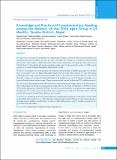Please use this identifier to cite or link to this item:
https://hdl.handle.net/20.500.14356/1071Full metadata record
| DC Field | Value | Language |
|---|---|---|
| dc.contributor.author | Bhujel, Sapana | - |
| dc.contributor.author | Khadka, Rakshya | - |
| dc.contributor.author | Baskota, Swechhya | - |
| dc.contributor.author | Poudel, Lisasha | - |
| dc.contributor.author | Bista, Suman | - |
| dc.contributor.author | Gurung, Minani | - |
| dc.contributor.author | Neupane, Tamanna | - |
| dc.contributor.author | Adhikari, Bikram | - |
| dc.date.accessioned | 2023-04-23T05:43:11Z | - |
| dc.date.available | 2023-04-23T05:43:11Z | - |
| dc.date.issued | 2021 | - |
| dc.identifier.citation | BhujelS., KhadkaR., BaskotaS., PoudelL., BistaS., GurungM., NeupaneT., & AdhikariB. (2021). Knowledge and Practice of Complementary Feeding among the Mothers of the Child Aged Group 6-24 Months, Tanahu Distirct, Nepal. Journal of Nepal Health Research Council, 19(1), 127-134. https://doi.org/10.33314/jnhrc.v19i1.3371 | en_US |
| dc.identifier.issn | Print ISSN: 1727-5482; Online ISSN: 1999-6217 | - |
| dc.identifier.uri | http://103.69.126.140:8080/handle/20.500.14356/1071 | - |
| dc.description | Original Article | en_US |
| dc.description.abstract | Abstract Background: Early and late introduction of complementary feeding is associated with increased morbidity and nutritional deficiencies in children. In 2016, the under 5 mortality rate of Nepal was 39 deaths per 1000 live births and around 1 million under 5 children had suffered from chronic malnutrition. The main aim of this study was to identify the level of knowledge and practice regarding complementary feeding among the mothers of children aged group 6 to 24 months in Bhanu Municipality, Tanahu District, Nepal. Methods: A descriptive cross-sectional study was conducted with 158 mothers of children age group 6 to 24 months from ward number 1 and 2 in Bhanu Municipality, Tanahu District, Nepal. Data collection was done after taking ethical approvalby using a semi-structured questionnaire via face-to-face interviews. Collected data were entered and descriptive analysis was carriedout in Statistical Package for the Social Services version 20. Categorical variables were presented using frequency and percentage. Clopper-pearson method was used to determine 95% confidence interval. Results: Out of 158 respondents, 26.6% (95%CI:19.9,34.2) had inadequate knowledge, whereas 73.4% (95%CI:65.8, 80.1) had adequate knowledge on complementary feeding. Likewise, the study revealed that 51.9%(95%CI: 43.8, 59.9) did the right practice, while 48.1%(95%CI: 40.1,56.2) were involved in the wrong practice on complementary feeding. Only 39 % mothers gained the knowledge about complementary feeding from the health workers. 2.5% of mother had exclusively breastfed their child up to just 3 months. Conclusions: Despite the good level of knowledge about complementary feeding, the wrong practice was prevalent in about half of the mothers. As a result, enhancing existing strategies and developing new intervention measures including capacity building of healthworkers to improve child feeding practices must be mandatory actions for the government and policymakers. Keywords: Complementary feeding; knowledge; Nepal; practice | en_US |
| dc.language.iso | en | en_US |
| dc.publisher | Nepal Health Research Council | en_US |
| dc.relation.ispartofseries | Jan-March, 2021;3371 | - |
| dc.subject | Complementary feeding | en_US |
| dc.subject | knowledge | en_US |
| dc.subject | Nepal | en_US |
| dc.subject | practice | en_US |
| dc.title | Knowledge and Practice of Complementary Feeding among the Mothers of the Child Aged Group 6-24 Months, Tanahu Distirct, Nepal | en_US |
| dc.type | Journal Article | en_US |
| local.journal.category | Original Article | - |
| Appears in Collections: | Vol. 19 No. 1 (2021): Vol. 19 No. 1 Issue 50 Jan-Mar 2021 | |
Files in This Item:
| File | Description | Size | Format | |
|---|---|---|---|---|
| 3371-Manuscript-21564-1-10-20210425.pdf | Fulltext Download | 332.34 kB | Adobe PDF |  View/Open |
Items in DSpace are protected by copyright, with all rights reserved, unless otherwise indicated.
